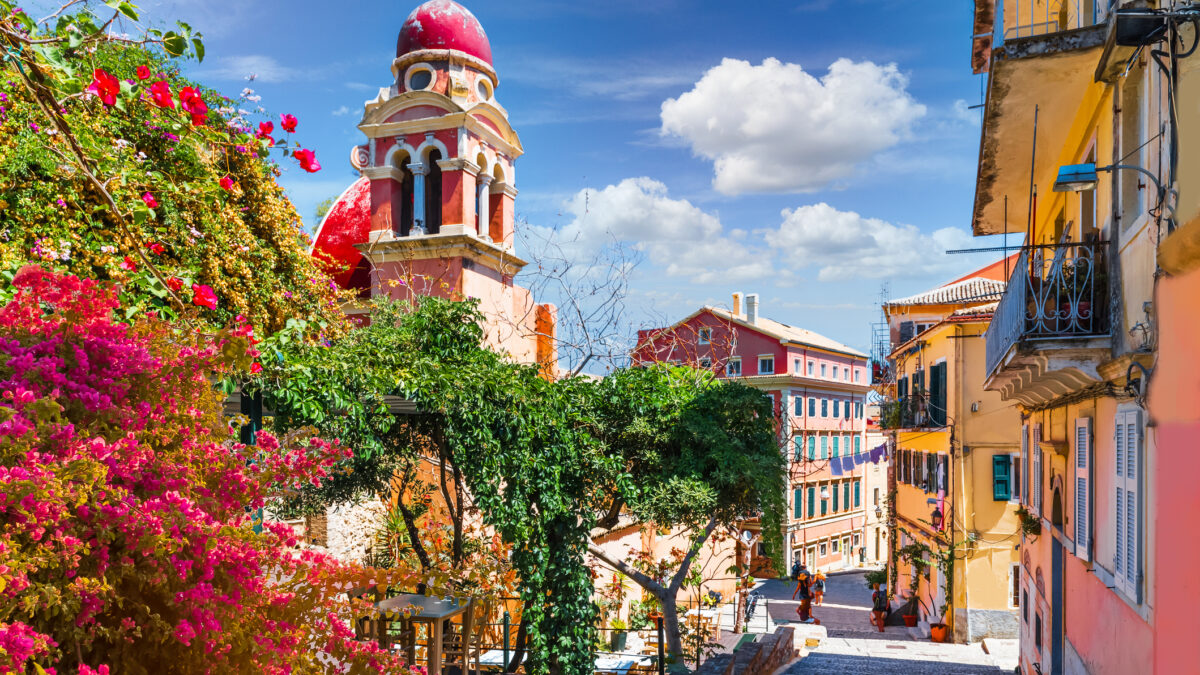Multicultural Corfu, land of the Phaeacians, the Countess of the Ionian, is one of Greece’s most popular islands. Displaying the influences of numerous cultures that controlled it, with its unparalleled natural beauty and a fascinating culinary culture, it is no coincidence that it attracts so many visitors.
The northernmost of the Ionian Islands, Corfu has been settled for thousands of years, with findings from the Palaeolithic and Neolithic periods. Indeed, as the myth has it, the god Poseidon took the nymph Korkyra, daughter of Asopos, captive and spirited her off to the island, which is named for her. The earliest reference to Corfu in mythology is in Homer’s ‘Iliad’. Referred to as the ‘island of the Phaeacians’ in that work, Corfu was among Odysseus’ stops on his journey home to Ithaca. The more than 400 years of Venetian rule, as well as the periods of French and British rule, have left their own cultural imprints on the island. The Venetian aspect is dominant in the Old Town of Corfu, visible in the architecture, much-photographed clotheslines that span the Venetian-style balconies, the dialect, right down to the local dishes.
The Old Town has been recognised as a UNESCO World Heritage Site and has no shortage of sights to see. Spianada central square – the largest in the Balkans – and the neighbouring Liston district, the Old and New Fortresses, the church of the city’s patron saint, Agios Spyridon, the Kabielo and Town Hall Square are just some of the sights worth seeing. Beyond the Old Town, notable sites include the Achilleion Palace, Mon Repos Palace, and the Panagia of Vlacherna, among others. The latter two can be found in the area of the Chalkiopoulos Lagoon. Correspondingly, the Korissia Lagoon in the island’s south is part of the Natura 2000 network and serves to demonstrate the area’s truly impressive natural wealth. Corfu is dotted with picturesque villages, such as Ano Perithia – the island’s highest settlement – alongside seaside locales such as Palaiokastritsa, which evokes a bygone age while its crisp, crystal-clear waters draw swimmers looking for a challenge. Corfu’s beaches attract visitors with their diversity. From organised affairs straddled by colossal hotels or vibrant beach bars to free beaches, whether sandy, pebble-strewn, immersed in lush vegetation or wild and pristine, the island’s beaches are sure to impress with their crystal-clear waters and unparalleled natural beauty. In addition, the Easter celebrations in Corfu are among the most storied in Greece.
Gastronomy
Historically, the cuisine of Corfu was deeply influenced by the Venetians. So, it is no coincidence that most of the island’s signature dishes have Italian names. Most emblematic among them is pastitsada with rooster, a melding of herbs and aromatic plants, red wine, generous dashes of cinnamon and nutmeg, meat and thick pasta served with roughly grated kefalotyri cheese. Only slightly less renowned among the local dishes is sofrito: veal fillets served with a characteristic garlicky white sauce. Bianco, fish cooked in a pot with potatoes, onions, pepper and a generous dose of lemon, is another enduringly popular dish in the local tradition, as is bakaliaros (cod) aliada. The locals also make bourdeto – a fish dish cooked in a spicy red sauce. Also part of the island’s cuisine is the popular savoro (a vinegar-based sauce used to preserve small fried fish), a dish it shares with the cuisines of other islands.
Accompanying the island’s famous dishes are its renowned local products. Corfu’s olives produce some of Greece’s finest olive oil, the island’s honey is exceptional, and wine lovers are sure to appreciate the local varieties at organised wineries and restaurants. And of course, visitors to the famous home of the Pheaecians should not miss the opportunity to try the local ginger beer and classic beers. Corfu is also home to extensive cultivation of kumquats, a citrus fruit of Japanese origin with the scientific name Citrus japonica that is used to produce liqueurs, among other things. It was originally introduced to the island by the British, and spoon sweets and liqueurs produced with it have been popular ever since. Corfu’s tiny strawberries are prized for their intense flavour and aroma. The island also produces cured meats, the most famous of which is nouboulo, while the selection of local products is rounded out by the sykomaida.
How to get there
Corfu is an island in the Ionian Sea, easily accessible by ferry from the ports of Piraeus, Patras and Igoumenitsa, or by air.










